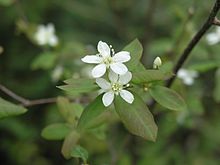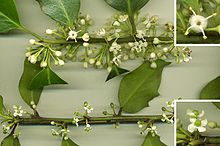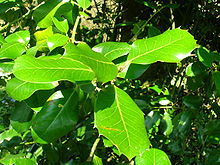
Holly
Background to the schools Wikipedia
SOS Children has tried to make Wikipedia content more accessible by this schools selection. SOS Children is the world's largest charity giving orphaned and abandoned children the chance of family life.
| Ilex | |
|---|---|
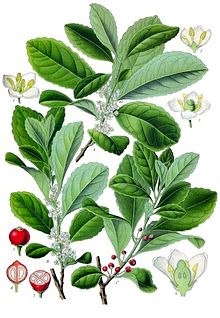 |
|
| Ilex paraguariensis | |
| Scientific classification | |
| Kingdom: | Plantae |
| Division: | Angiosperms |
| Class: | Eudicots |
| Order: | Aquifoliales |
| Family: | Aquifoliaceae DC. ex A.Rich. |
| Genus: | Ilex L. |
| Species | |
|
About 600, see text |
|
Ilex (pron.: / ˈ aɪ l ɛ k s /), or holly, is a genus of 400 to 600 species of flowering plants in the family Aquifoliaceae, and the only living genus in that family. The species are evergreen and deciduous trees, shrubs, and climbers from tropics to temperate zones worldwide.
Description
The genus Ilex is widespread throughout the temperate and subtropical regions of the world. It includes species of trees, shrubs, and climbers, with evergreen or deciduous foliage and inconspicuous flowers. Its range was more extended in the Tertiary period and many species are adapted to laurel forest habitat. It occurs from sea level to more than 2,000 metres (6,600 ft) with high mountain species. It is a genus of small, evergreen trees with smooth, glabrous, or pubescent branchlets. The plants are generally slow-growing with some species growing to 25 m (82 ft) tall. The type species is the European holly Ilex aquifolium described by Linnaeus,
Plants in this genus have simple, alternate glossy leaves, typically with a spiny toothed, or serrated leaf margin. The inconspicuous flower is greenish white, with four petals. They are generally dioecious, with male and female flowers on different plants, although there are exceptions.
The small fruits of Ilex, although often referred to as berries, are technically drupes. They range in colour from red to brown to black, and rarely green or yellow. The "bones" contain up to ten seeds each. Some species produce fruits parthenogenetically, such as the cultivar 'Nellie R. Stevens'. The fruits ripen in winter and thus provide winter colour contrast between the bright red of the fruits and the glossy green evergreen leaves. Hence the cut branches, especially of I. aquifolium, are widely used in Christmas decoration. The fruits are generally slightly toxic to humans, and can cause vomiting and diarrhea when ingested. However, they are a very important food source for birds and other wildlife.
Etymology
Ilex in Latin means the holm-oak or evergreen oak ( Quercus ilex). Despite the Linnaean classification of Ilex as holly, as late as the 19th century in Britain, the term Ilex was still being applied to the oak as well as the holly - possibly due to the superficial similarity of the leaves. The name "holly" in common speech refers to Ilex aquifolium, specifically stems with berries used in Christmas decoration. By extension, "holly" is also applied to the whole genus. The origin of the word "holly" is considered a reduced form of Old English hole(ġ)n, Middle English Holin, later Hollen. The French word for holly, houx, derives from the Old Low Franconian *hulis (Middle Dutch huls). Both are related to Old High German hulis, huls, as do Low German/ Low Franconian terms like Hülse or hulst. These Germanic words appear to be related to words for holly in Celtic languages, such as Welsh celyn, Breton kelen(n) and Irish cuileann.
Several romance languages use the Latin word acrifolium (turned into aquifolium in modern time), so Italian agrifoglio, Occitan grefuèlh, etc.
History
The phylogeography of this group provides examples of various speciation mechanisms at work. In this scenario ancestors of this group became isolated from the remaining Ilex when the Earth mass broke away from Gondwana and Laurasia about 82 million years ago, resulting in a physical separation of the groups and beginning a process of change to adapt to new conditions. This mechanism is called allopatric speciation. Over time survivor species of the holly genus adapted to different ecological niches. This led to reproductive isolation, an example of ecological speciation. In the Pliocene, around five million years ago, the formation of the new orogeny diversified the landscape and provided new opportunities for speciation within the genus.
The fossil record indicates that the Ilex lineage was already widespread prior to the end of the Cretaceous period. Based on the molecular clock the common ancestor of most of the extant species probably appeared during the Eocene, about 50 million years ago, suggesting that older representatives of the genus belong to now extinct branches. The laurel forest covered great areas of the Earth during the Paleogene, when the genus was more prosperous. This type of forest extended during the Neogene, more than 20 million years ago. Most of the last remaining temperate evergreen forests are believed to have disappeared about 10,000 years ago at the end of the Pleistocene. Many of the then existing species with the strictest ecological requirements became extinct because they could not cross the barriers imposed by the geography, but others found refuge as a species relict in coastal enclaves, archipelagos, and coastal mountains sufficiently far from the extreme cold and aridity and protected by the oceanic influence.
The genus includes about 400 to 600 species, divided into three subgenera:
- Ilex subg. Byronia, with the type species Ilex polypyrena
- Ilex subg. Prinos, with 12 species
- Ilex subg. Ilex, with the rest of the over 400 species
Range
The genus is distributed throughout the world's different climates. Most species make their home in the tropics and subtropics, with a worldwide distribution in temperate zones. The greatest diversity of species is found in the Americas and in Southeast Asia.
Ilex mucronata, formerly the type species of Nemopanthus, is native to eastern North America. Nemopanthus was treated as a monotypic genus with eight species. of the family Aquifoliaceae, now transferred to Ilex on molecular data; it is closely related to Ilex amelanchier.
In Europe the genus is represented by a single species, the classically named holly Ilex aquifolium. In continental Africa this species and ( Ilex mitis). Ilex canariensis Macaronesia and Ilex aquifolium arose from a common ancestor in the laurel forests of the Mediterranean. Australia, isolated at an early period, has ( Ilex arnhemensis). Of 204 species growing in China, 149 species are endemic. A species which stands out for its economic importance among the Spanish-speaking countries is Ilex paraguariensis or Yerba mate. Having evolved numerous species that are endemic to islands and small mountain ranges, and being highly useful plants, many hollies are now becoming rare.
Ecology
Often the tropical species are especially threatened by habitat destruction and overexploitation. At least two species of Ilex have become extinct recently, and many others are barely surviving. The fruits are toxic to humans, though their poisonous properties are overstated and fatalities are almost unknown. They are extremely important food for numerous species of birds, and also are eaten by other wild animals. In the autumn and early winter the fruits are hard and apparently unpalatable. After being frozen or frosted several times, the fruits soften, and become milder in taste. During winter storms, birds often take refuge in hollies, which provide shelter, protection from predators (by the spiny leaves), and food. The flowers are sometimes eaten by the larva of the Double-striped Pug moth (Gymnoscelis rufifasciata). Other Lepidoptera whose larvae feed on holly include Bucculatrix ilecella, which feeds exclusively on hollies, and The Engrailed (Ectropis crepuscularia).
Toxicity
The berries of various species contain Theobromine, a compound similar to caffeine. In very small doses, theobromine and other caffeines only mildly stimulate the nervous system. However larger amounts can cause dizziness, stomach pain, nausea, diarrhoea, elevated pulse rate, and low blood pressure, as well as drowsiness.
Berries attract birds that eat them after the frosts have reduced toxicity. However, if household pets ingest Holly, they are very liable to be poisoned, and it is a very good idea to keep holly decorations out of reach of pets and/or children.
Cultivation
Many of the holly species are widely used as ornamental plants in gardens and parks, notably:-
- I. aquifolium (common European holly)
- I. crenata (box-leaved holly)
- I. verticillata (winterberry)
Moreover, many hundreds of hybrids and cultivars have been developed for garden use, among them the very popular " Highclere holly", Ilex × altaclerensis (I. aquifolium × I. perado) and the "blue holly", Ilex × meserveae (I. aquifolium × I. rugosa). Hollies are often used for hedges; the spiny leaves make them difficult to penetrate, and they take well to pruning and shaping.
Other uses
Several holly species are used to make caffeine-rich herbal teas. The South American Yerba Mate (I. paraguariensis) is boiled for the popular revigorating drinks Mate, and Chimarrão, and steeped in water for the cold Tereré. Guayusa (I. guayusa) is used both as a stimulant and as an admixture to the entheogenic tea ayahuasca; its leaves have the highest known caffeine content of any plant. In North and Central America, Yaupon (I. vomitoria), was used by southeastern Native Americans as a ceremonial stimulant and emetic known as "the black drink". As the name suggests, the tea's purgative properties were one of its main uses, most often ritually. Gallberry (Appalachian Tea, I. glabra) is a milder substitute for Yaupon and does not have caffeine. In China, the young leaf buds of I. kudingcha are processed in a method similar to green tea to make a tisane called kǔdīng chá (苦丁茶, roughly "bitter spikeleaf tea").
Between the thirteenth and eighteenth centuries, before the introduction of turnips, holly was cultivated for use as winter fodder for cattle and sheep. Less spiny varieties of holly were preferred, and in practice the leaves growing near the top of the tree have far fewer spines making them more suitable for fodder.
Holly was also once among the traditional woods for Great Highland bagpipes before tastes turned to imported dense tropical woods such as cocuswood, ebony, and African blackwood.
Culture
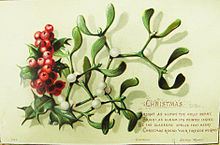
Holly - more specifically the European holly, Ilex aquifolium - is commonly referenced at Christmas time. In many western cultures, holly is a traditional Christmas decoration, used especially in wreaths and illustrations, for instance on Christmas cards. Since medieval times the plant has carried a Christian symbolism, as expressed in the well-known carol " The Holly and the Ivy". However, the association of holly with winter celebrations almost certainly pre-dates Christianity. Druids wore holly wreaths on their heads.
In heraldry, holly is used to symbolise truth.
The Norwegian municipality of Stord has a yellow twig of holly in its Coat-of-arms.
In the extremely popular and best-selling Harry Potter novels, holly is used as the wood in the titular character's wand.
Selected species
- Ilex abscondita
- Ilex acutidenticulata
- Ilex affinis
- Ilex × altaclarensis
- Ilex altiplana
- Ilex amara – Caachira
- Ilex ambigua – Sand Holly
- Ilex amelanchier – Swamp Holly
- Ilex anomala Hook. & Arn. – Kāwaʻu ( Hawaiʻi)
- Ilex anonoides
- Ilex aquifolium – European Holly, English Holly, Christ's Thorn
- Ilex aquifolium 'Ferox' – Hedgehog holly
- Ilex aracamuniana
- Ilex argentina
- Ilex arisanensis
- Ilex arnhemensis – Northern Holly (Northern Australia)
- Ilex bioritsensis
- Ilex brachyphylla
- Ilex brasiliensis
- Ilex brevicuspis
- Ilex brevipedicellata
- Ilex buergeri
- Ilex canariensis – Small-leaved Holly, Acebino
- Ilex caniensis
- Ilex cassine – Dahoon Holly, Cassena
- Ilex centrochinensis
- Ilex cerasifolia
- Ilex chamaedryfolia
- Ilex chapaensis
- Ilex chengkouensis
- Ilex chinensis
- Ilex chuniana
- Ilex ciliolata
- Ilex ciliospinosa
- Ilex cognata
- Ilex colchica
- Ilex collina
- Ilex conocarpa
- Ilex cookii – Cook's Holly (Puerto Rico)
- Ilex corallina
- Ilex coriacea – Gallberry
- Ilex cornuta – Chinese Holly, Horned Holly
- Ilex costaricensis
- Ilex cowanii
- Ilex crenata – Japanese Holly, Box-leaved Holly, inutsuge ( Japanese)
- Ilex crepitans
- Ilex cyrtura
- Ilex dabieshanensis
- Ilex davidsei
- Ilex decidua Walter – Possumhaw (Eastern United States, Northeastern Mexico)
- Ilex dehongensis
- Ilex dimorphophylla
- Ilex diospyroides
- Ilex dipyrena – Himalayan Holly
- Ilex dumosa
- Ilex ericoides
- Ilex euryoides
- Ilex fargesii
- Ilex fengqingensis
- Ilex fertilis
- Ilex florifera
- Ilex gardneriana (extinct: 20th century?)
- Ilex geniculata
- Ilex georgei
- Ilex gigantea
- Ilex glabella
- Ilex glabra L. A.Gray – Evergreen Winterberry, Bitter Gallberry, Inkberry (Eastern North America)
- Ilex gleasoniana
- Ilex goshiensis
- Ilex graciliflora
- Ilex grandiflora
- Ilex guaiquinimae
- Ilex guayusa – Guayusa
- Ilex guianensis
- Ilex harrisii
- Ilex holstii
- Ilex huachamacariana
- Ilex humboldtiana
- Ilex ignicola
- Ilex illustris
- Ilex integerrima
- Ilex integra – Mochi Tree, Nepal Holly
- Ilex intricata
- Ilex jamaicana Proctor (Jamaica)
- Ilex jauaensis
- Ilex jelskii
- Ilex karuaiana
- Ilex khasiana
- Ilex kingiana
- Ilex kudingcha
- Ilex kusanoi
- Ilex laevigata – Smooth Winterberry
- Ilex lasseri
- Ilex latifolia – Tarajo Holly, tarayō (Japanese)
- Ilex lechleri
- Ilex leucoclada
- Ilex longipes
- Ilex longzhouensis
- Ilex machilifolia
- Ilex maclurei
- Ilex macoucoua
- Ilex macrocarpa
- Ilex macropoda
- Ilex magnifructa
- Ilex maingayi
- Ilex marahuacae
- Ilex marginata
- Ilex margratesavage
- Ilex mathewsii
- Ilex × meserveae
- Ilex microdonta
- Ilex mitis
- Ilex montana Torrey & A.Gray – Mountain Winterberry ( Eastern United States)
- Ilex mucronata (L.) M.Powell, Savol., & S.Andrews – Mountain Holly, Catberry (Eastern North America)
- Ilex myrtifolia – Myrtle Holly, Myrtle Dahoon
- Ilex neblinensis
- Ilex nothofagifolia
- Ilex oblonga
- Ilex occulta
- Ilex opaca – American Holly (Eastern United States)
- Ilex ovalifolia
- Ilex palawanica
- Ilex pallida
- Ilex paraguariensis – Maté, yerba maté, erva-mate (Portuguese)
- Ilex parvifructa
- Ilex patens
- Ilex pauciflora
- Ilex paujiensis
- Ilex pedunculosa – Longstalked holly
- Ilex peiradena
- Ilex perado – Madeiran Holly
- Ilex perlata
- Ilex pernyi – Perny's Holly
- Ilex polita
- Ilex praetermissa
- Ilex pringlei
- Ilex pseudobuxus
- Ilex puberula
- Ilex pubescens
- Ilex pubiflora
- Ilex purpurea
- Ilex qianlingshanensis
- Ilex quercetorum
- Ilex quercifolia
- Ilex rarasanensis
- Ilex reticulata
- Ilex rotunda
- Ilex rugosa
- Ilex sclerophylla
- Ilex serrata – Japanese Winterberry
- Ilex sessilifructa
- Ilex shimeica
- Ilex sikkimensis
- Ilex sintenisii (Urban) Britt. – Sintenis' Holly (Puerto Rico)
- Ilex sipapoana
- Ilex socorroensis
- Ilex spinigera
- Ilex spruceana
- Ilex steyermarkii
- Ilex subrotundifolia
- Ilex subtriflora
- Ilex sugerokii
- Ilex sulcata
- Ilex syzygiophylla
- Ilex tahanensis
- Ilex tateana
- Ilex taubertiana
- Ilex ternatiflora (extinct: 20th century?)
- Ilex theezans
- Ilex tiricae
- Ilex tolucana
- Ilex trachyphylla
- Ilex trichocarpa
- Ilex tugitakayamensis
- Ilex uraiensis
- Ilex vaccinoides
- Ilex venezuelensis
- Ilex venulosa
- Ilex verticillata (L.) A.Gray American Winterberry (Eastern North America)
- Ilex vomitoria – Yaupon Holly, casseena (Spanish)
- Ilex vulcanicola
- Ilex wenchowensis
- Ilex williamsii
- Ilex wilsonii
- Ilex yunnanensis
- Ilex wugonshanensis
- Ilex yuiana

